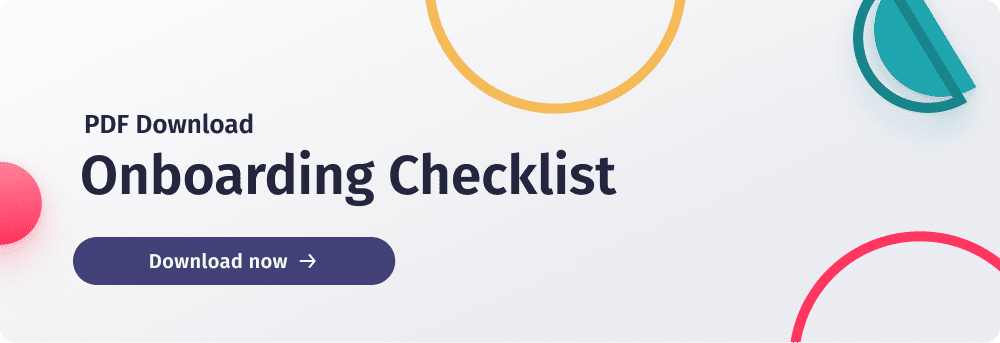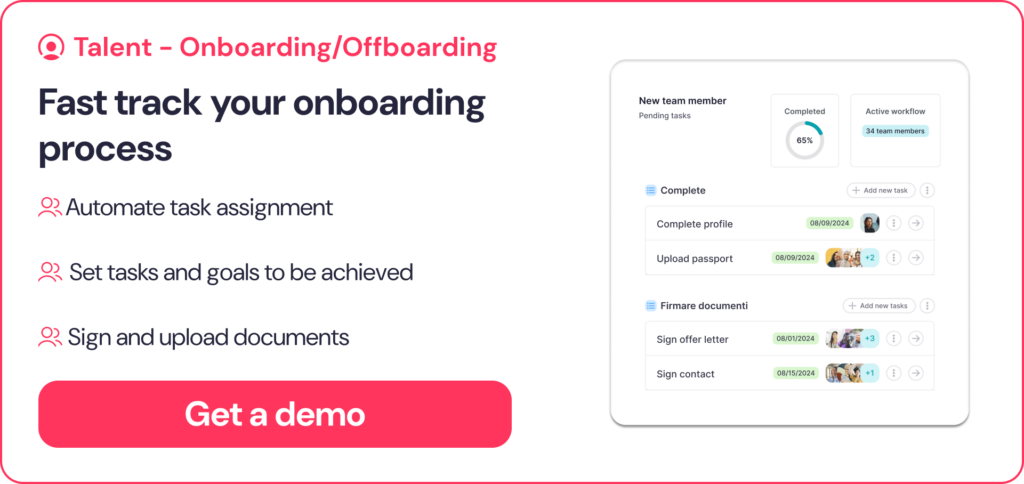Did you know that in the UK 43 percent of millennials plan to leave their current jobs within two years and only 28 per cent have plans to stay beyond five years? You can make sure your company doesn’t add to these statistics by implementing an effective employee onboarding process plan, that goes beyond simply the job offer.
The first few days, weeks, and months, are crucial to forming a good working relationship between an employee and the company. Many of the fundamental steps required for the onboarding process are often overlooked. For this reason, we’ve put together this employee onboarding guide, with some key steps, tips, and important information to guarantee a successful onboarding.
Do you need an Onboarding plan?
Yes! If you want to retain your employees and help set them up for success, a plan for onboarding is essential. This will not only help them fully integrate into the company, but will help kick start their success in their role.
Before we dive in, it’s important to note, that onboarding isn’t only about passing over a manual and a description of duties to a new worker. There is so much more involved in the process of welcoming and integrating staff into the team.
It is important that every new employee feels satisfied and comfortable in the company. Ensuring new employee satisfaction is the only real way to prevent them from leaving during the first weeks.
Guarantee a successful hiring process! 👇
Do you know how to design an effective HR onboarding process?
Developing a strong employee onboarding plan is a key responsibility of the HR department. Your main role early on is to help the new hire settle into their work environment. This means providing them with resources, explaining different workflows, and other practical office knowledge. The new employee onboarding process should be tailored to each role and department, helping newcomers understand the company and team responsibilities.
If you are curious to learn more about how to design an effective onboarding process, continue reading. We will guide and teach you about what should be included in your welcome plan for employees, but first, you need to understand one thing.
What is the onboarding process?
The process of onboarding details a plan of action that is designed by the company to help their new employees effectively adapt to their role and corresponding duties.
The duration of the employee onboarding process can last anywhere from 45 days to one year, depending on the characteristics of the job and the skills of the new worker.
The new employee must know:
- Where they will perform their duties
- The means of work
- The habits of the company and the company culture
Effective Employee Onboarding Process: The Benefits
The process of onboarding has many benefits for companies just as much as for its workers, here are some of them:
-
- Reduces future hiring costs – The better the onboarding, the less likely you’ll have new employees abandon their roles early on. As a result, a company will not need to spend money on another round of recruitment and onboarding.
-
- Improves employee retention – The chances of highly skilled workers leaving their job are reduced. Invest in proper employee training to make sure your employees stay in the company.
-
- Increases productivity – Happier workers are more productive. Take the time to nurture a healthy work environment to increase employee engagement.
-
- Quicker adaptation – Workers who receive more guidance integrating into the company, will adapt better and be more successful. Your onboarding process helps them build a solid foundation and be able to hit the ground running.
-
- Greater identification with the brand – Encouraging employees to become more involved in the company activities, results in a greater investment in the company, its values, and the brand as a whole.
-
- Builds stronger workplace relationships – Onboarding new employees and welcoming them to the team, by introducing them early on to their co-workers, naturally facilitates teamwork.
-
- Improved company image – Integrating recent arrivals with an onboarding plan does a favor to the company. This action puts forward the impression that the company is concerned about its employees from day one.
Tips for Creating an Employee Onboarding Process Plan
Before selecting the ideal candidate to cover the job vacancy, you must first create an employee onboarding process plan and decide the actions that you will take, starting with how you plan to communicate with the employee. All of these initial steps are essential to ensure a pleasant professional experience while establishing healthy connections between the company and the new worker.
As you go through the next section, you can create your own employee onboarding Process checklist, based on your company requirements, from the information below.
Before Hiring: analysis
In the initial phase, your company must be clear about the values, mission, culture, the business strategy so that you can communicate this information to the new employees. You should also gather information about the functions required of each role, and the internal and external references with which the new worker will have a direct relationship. Also, before beginning the hiring process, make sure you don’t make these recruitment mistakes.
Pre-Onboarding Process
This period includes the moment from when the selected candidate receives their offer until they are officially hired. As pre-onboarding is the duty of the human resources department, your responsibilities at this stage will be as follows:
1. Collection of documents
To create a good onboarding plan for employees, it is necessary to collect all of the employee information so that the initiation of the working relationship can be communicated with social security.
The required documents may vary from country to country, but in general, they are as follows:
- Social security number
- Copy of their ID or work permit if they are not a citizen. In this case, be very careful to make a note of the expiration date, so the company knows, until when the individual can legally work.
- Supporting documents: although not required by social security, some companies may request additional documents such as a criminal record check.
2. Registering with Social Security – What to know
- Hiring employees who don’t have the proper documents could prove troublesome for the company; especially in the case of an inspection.
- Before registering with social security, the new employee cannot officially be given a start date. Once the employee is successfully registered in the system, they can work.
- When registering the employee, you must determine the professional category and their functions to determine their contribution group. Depending on the country, there are many different contribution groups from which you will need to select and group your workers, as per social security requirements. It is also necessary to inform social security, which type of contract each employee will have. Will the contract be indefinite or temporary? Is it full-time or part-time? And, if the contract is part-time, what will the days and hours be for each worker.
3. Communication with the future worker
For an onboarding process to be effective, it is important to maintain constant communication with future employees. At times, it is common for workers to receive other offers while they are waiting to enter their position in a company, this is why it is essential to maintain communication. Without proper follow up, the new employee may back out if they receive a better offer.
Take advantage of the first few days, following the signing of the offer letter, to provide your new member with a proper welcome. Use this time to explain to them what their functions will be, the type of contract they will have, and what they will be required to do in their role.
4. Collecting employee contact details
The other details you can ask from your future employee are those which will be reflected in the contract:
- Level of studies
- Nationality
- Address
The employee must communicate to the company, any modification or change to their address. In the case that the employee leaves, you will need the most updated information to contact them with.

First day of work
Welcome
Organising a welcome session for your new employee is the first thing you should arrange. The proper welcome will ensure the new employee feels comfortable and well received by the company. You can organize the welcome in several ways. Some of these may include, recording a welcome video, carrying out group activities, presenting the new member to their co-workers, etc. Giving a gift to new staff is also a great way to make them feel welcome.
Collection of Information
Fundamentally, every onboarding plan for employees includes a collection of the employee’s basic data; this is an essential part of the hire paperwork and is separate from the data which is sent to social security.
The first thing the employee must do is fill in the correct tax form to calculate their IRPF. This information enables the company to know the employee’s tax base. From this, their taxes can be correctly calculated based on each employee’s situation.
At this stage, you can also request a bank account for where you can pay the employee’s salary. Requesting an email is also beneficial so you can send them their payslip.
✅Don't forget to download your Onboarding Checklist
Signing the contract
After you have collected all the required data, you must sign the original contract with the employee in writing. Although you may have a verbal contract in place, and this does hold legal validity, it is not advisable to rely solely on this. Having only a verbal contract does not provide any legal certainty for either party. Verbal contracts leave many things unregulated, such as the trial period, which if not specified in writing, holds no weight.
Furthermore, make sure you have two official copies of the contract. One copy for the company and the other to give to the new employee. Companies that don’t provide the employee with a copy of their contract, risk committing an infraction.
- Temporary contracts – By law, these must be made in an official format and reflected in writing.
- Indefinite contracts – Unlike a temporary contract, indefinite contracts don’t need to be in an official format. The only exception, in this case, is contracts that include a benefit or belong to a special group.
Note: To take advantage of a benefit, employees must provide the necessary documentation to prove the legitimacy of their disability or to verify their eligibility to access a specific benefit.
Many companies often overlook these minor yet important contract details; however, they are details you must include when designing a good onboarding plan.
Tools for the job
Although not required by law, you must provide the employee with the means required to perform the job: ie. car, mobile phone, computer, etc. Also, you must provide access and passwords to the systems the employee will be required to use.
Management of 3rd Party Data
If you are sharing employee data with third parties, each employee must sign a third party waiver that confirms they are aware their data will be shared.
The employee data you collect will most often be kept for internal use; however, you may also need to send it to third parties. An example of this would include times when you need to request advice from an advisory. This situation happens when a company needs to carry out communications to administrators or external companies they will work with.
Data Protection
The new employee must be provided training on data protection. This is vitally important if they have access to a third-party database, such as customer data. If the case there is an information leak, the company could be sanctioned. Due to this, the worker must sign a paper that indicates that he/she has participated in the proper data protection training program so that the company can be exempt from blame.
Workplace Risk Prevention & Health Surveillance
When onboarding new employees, workers must receive training on how to prevent workplace accidents. Also, you must provide the worker with the necessary personal protective equipment if required by the role. You must have the employee sign something that confirms they have received the proper training. In the case, someone comes to inspect, this documentation will be requested.
Also, depending on the sector of work (ie. construction, power plants), you may be required to offer medical examinations to your workers. Workers can refuse to have the medicals conducted; however, they must sign a refusal letter, so they cannot later claim the company hasn’t fulfilled their duty.
Workplace Procedures
When you design an onboarding plan for your employees, keep in mind, that some legal regulations require you to operate in a certain way. For example, in 2019, Spain made a law that required all workers to track their hours; clocking in and out when they enter and exit the premises.
If the country you are working in, requires employees to clock in and out, it is necessary to inform employees of the time tracking system so they are aware of the procedure they must follow.
Let’s talk about surveillance!
Special care must be taken if the worker will be under surveillance during their shift. If this is the case, the employee must sign a waiver to allow the company the right to record.
Confidential Information
Otherwise know, as sensitive business information or trade secrets which are essentially the intellectual property of the company. If an employee is required to know any confidential company information (ie. a plan for a certain product, how to attract customers etc.) this may be indicated in the contract. The employee must sign and confirm that they will not be sharing any company sensitive information. Any individual sharing company information without consent could face penalties.
As you can see, many steps must be followed during the first day to ensure the process of onboarding runs smoothly and doesn’t become too intense or overwhelming. The company must facilitate the hassle-free adaptation of the employee into their new environment.
The First Week
Once the first day is complete, the employer should always follow up with the employee. A follow up fairly early on is a good idea and allows you to evaluate whether the employee feels comfortable in their work environment.
Here are some additional things you can do as an HR manager, to help the new employee along.
Assign a mentor
One of the best ways to help your new employees transition into the workplace is by assigning them a mentor. This mentor can guide them as they learn their tasks so that eventually, they can perform them fully on their own.
Periodic meetings
Make time to meet with your new employee every 15 to 20 days. This is a great time to check in with your employees and determine whether they require anything to help them out. Following the initial 90 days, a review should be set up to evaluate the performance and adjustment of the employee, to their environment, other team members, and their role as a whole.
Completing the Onboarding Process
Once the employee has perfectly adapted to their role and the philosophy of the company, the new hire onboarding is complete. It is beneficial for the employer to ask the employee about their onboarding experience. Doing so will help the employer draw positive and negative conclusions that will help improve future onboarding plans.
In conclusion, the process of onboarding has substantial benefits for both the company and the worker. Most importantly, a proper HR onboarding of employees helps build a solid relationship between the two and builds lasting bonds. It is crucial to have a process of onboarding in place so that you can ensure your new employees adapt well. Furthermore, this will help them establish a good foundation for working within their position, which will result in more overall productivity for the company.
Do your employees a favour by supporting them as they transition into their roles. Get your free Factorial trial today.




